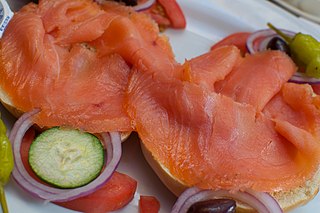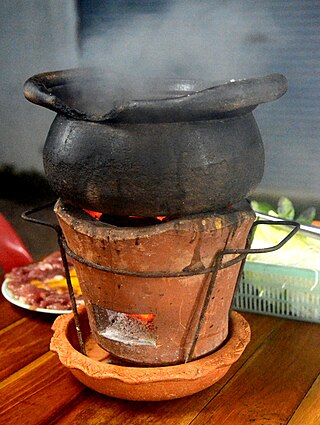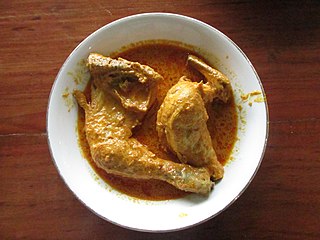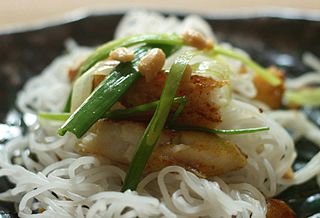
Chowder is a thick soup prepared with milk or cream, a roux, and seafood or vegetables. Oyster crackers or saltines may accompany chowders as a side item, and cracker pieces may be dropped atop the dish. New England clam chowder is typically made with chopped clams and diced potatoes, in a mixed cream and milk base, often with a small amount of butter. Other common chowders include seafood chowder, which often consists of fish, clams, and other types of shellfish; lamb or veal chowder made with barley; corn chowder, which uses corn instead of clams; various fish chowders; and potato chowder, which is often made with cheese. Fish, corn, and clam chowders are popular in North America, especially Atlantic Canada and New England.

Sashimi is a Japanese delicacy consisting of fresh raw fish or meat sliced into thin pieces and often eaten with soy sauce.

Tempura is a typical Japanese dish that usually consists of seafood and vegetables that have been coated in a thin batter and deep fried. Tempura has its origins dating back to the 16th century, when Portuguese Jesuits brought the Western-style cooking method of coating foods with flour and frying, via Nanban trade.
The Surreal Gourmet is a Canadian cooking program on Food Network, hosted by Bob Blumer.

Lox is a fillet of brined salmon, which may be smoked. Lox is frequently served on a bagel with cream cheese, and often garnished with tomato, onion, cucumber, and capers.

Rémoulade is a cold sauce. Although similar to tartar sauce, it is often more yellowish, sometimes flavored with curry, and often contains chopped pickles or piccalilli. It can also contain horseradish, paprika, anchovies, capers and a host of other items.
Sweet and sour is a generic term that encompasses many styles of sauce, cuisine, and cooking methods. It is commonly used in East Asia and Southeast Asia and has been used in England since the Middle Ages. Sweet and sour sauce remains popular in Asian and Western cuisines.

Deviled eggs, also known as stuffed eggs, curried eggs or dressed eggs, are hard-boiled eggs that have been peeled, cut in half, and filled with the yolk, mixed with other ingredients such as mayonnaise and mustard. They are generally served cold as a side dish, appetizer or a main course during gatherings or parties. The dish's origin can be seen in recipes for boiled, seasoned eggs as far back as ancient Rome, where they were traditionally served as a first course. The dish is popular in Europe, North America and Australia.

Gravlax or graved salmon is a Nordic dish consisting of salmon that is cured using a mix of salt, sugar and dill. It is garnished with fresh dill or sprucetwigs and may occasionally be cold-smoked afterwards. Gravlax is usually served as an appetizer, sliced thinly and accompanied by hovmästarsås, dill and mustard sauce, either on bread or with boiled potatoes.

Bob Blumer was the creator and host of the Food Network shows The Surreal Gourmet, Glutton for Punishment, and the host of World's Weirdest Restaurants. He is also the author and illustrator of seven cookbooks, including the most recent Flavorbomb: A Rogue Guide to Making Everything Taste Better. Blumer was born and raised in Montreal, Quebec, but now resides in Los Angeles, California. Bob serves as an Ambassador to Second Harvest in Toronto spreading the word about food rescue and hunger relief. He is also an ambassador for Love Food Hate Waste, a National Canadian zero-waste initiative. He currently works as a spokesperson, does appearances, develops food-related content, and recently played a character loosely based on himself in the upcoming movie The Way to the Heart.
Norwegian cuisine in its traditional form is based largely on the raw materials readily available in Norway and its mountains, wilderness, and coast. It differs in many respects from continental cuisine through the stronger focus on game and fish. Many of the traditional dishes are the result of using conserved materials, necessary because of the long winters.

Poke is a dish of diced raw fish tossed in sauce and served either as an appetizer or a main course.

A fishcake is a culinary dish consisting of filleted fish or other seafood minced or ground, mixed with a starchy ingredient, and fried until golden.
Bukharan Jewish cuisine is the traditional cuisine originating from the Bukharian Jewish community of Central Asia, who now mostly reside in Israel, and the United States.
The idea of drinking whisky with food is considered outré by many, but there is a growing interest in pairing whiskies with complementary foods. The Scotch whisky industry has been keen to promote this. Single malts, pot-still whiskies, bourbons, and rye whiskies offer an interesting range of tastes and aromas, which are just as varied as wine. Jake Wallis Simons compares whiskies in bourbon casks to white wines, due to their lighter flavor, and those in sherry casks to red wines, with their greater fruitiness. A few Scottish cook books contain reference to the use of whisky in cooking, and a few traditional Scottish recipes that use whisky exist.

Chim chum is a Southeast Asian street food, popular especially in Thailand. It is traditionally made with chicken or pork and fresh herbs such as galangal, sweet basil, lemongrass and kaffir lime leaves, cooked in a small clay pot on a charcoal stove. It is often served with nam chim.

Gulai is a class of spicy and rich stew commonly found in the Malay Archipelago. The main ingredients of the dish are usually poultry, goat meat, beef, mutton, various kinds of offal, fish, and seafood, as well as vegetables such as cassava leaves, unripe jackfruit, and banana stem.

Ginataang isda is a Filipino fish stew made from fish and leafy vegetables in coconut milk with garlic, ginger, onion, patis or bagoong alamang, and salt and pepper. It is a type of ginataan. A common version of the dish, known as ginataang paksiw na isda or paksiw na isda sa gata, is additionally soured with vinegar. Ginataang isda is a type of ginataan.

Cha ca La Vong is a Vietnamese grilled fish dish, originally from Hanoi. The dish is traditionally made with hemibagrus, which is a genus of catfish. The fish is cut into pieces and marinated in a turmeric-based sauce, which often includes shrimp paste or fish sauce, ginger, and chili peppers. Sometimes, saffron is used instead of turmeric. It is then lightly grilled over charcoal. The dish is served in a hot pan coated with marinade sauce and herbs, particularly dill. Other herbs, such as scallions or basil, may be included. It is eaten with vermicelli rice noodles and peanuts. Cha Ca La Vong is considered a delicacy in Vietnam, as it is nearly exclusively served in restaurants and is not found in street food.
















